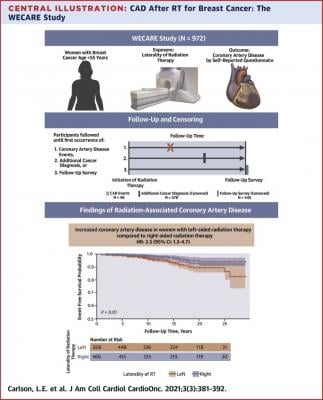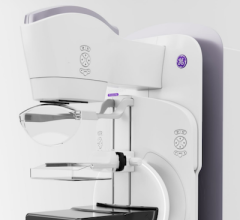
September 22, 2021 — Radiation therapy is an effective and widely used treatment for breast cancer. While the benefits of radiation therapy for breast cancer are clear, long-term complications related to radiation therapy may occur. According to a new study in JACC: CardioOncology, women with left-sided breast cancer undergoing radiation therapy between 1985 and 2008 had over twice the risk of subsequent coronary artery disease compared to women with right-sided breast cancer with up to 27.5 years of follow up.
“Nearly half of women diagnosed with breast cancer will undergo radiation therapy, which may expose the heart to incidental radiation. For those who are under 50 years old when diagnosed with breast cancer, their 10-year survival rate is over 90% for Stage I disease and more than 75% for Stage II disease,” said Gordon Watt, Ph.D., a postdoctoral research fellow at Memorial Sloan Kettering Cancer Center and a study author. “Our study adds to the growing evidence that left-sided radiation therapy is an independent risk factor for future heart disease after treatment for breast cancer. It is important that clinicians caring for younger breast cancer patients communicate the importance of radiation therapy for breast cancer while explaining the need for long-term attention to the risk of heart disease, particularly for women receiving left-sided radiation therapy. Radiation therapy is an indispensable part of breast cancer care, and the good news for breast cancer patients is that modern techniques and computerized treatment planning have reduced the amount of radiation that reaches the heart, thereby reducing the risk of developing heart disease.”
Researchers studied participants in the Women’s Environmental Cancer and Radiation Epidemiology Study to evaluate the risk of coronary artery disease in breast cancer survivors. After excluding women who did not receive radiation therapy or who had a preexisting cardiovascular disease diagnosis, 972 women were eligible for analysis. All the participants were diagnosed with breast cancer between 1985 and 2008, were under 55 years old and had completed a cardiovascular health questionnaire. Clinical and lifestyle factors were distributed equally among both groups of women. The average follow-up time was 14 years.
Radiation-associated heart disease has a latency of at least five years, therefore requiring long-term follow-up of breast cancer survivors. Previous studies in older populations have shown left-sided radiation therapy is associated with increased risk of developing heart disease, although the level of risk varied between studies. According to the researchers, the risk of heart disease after receiving radiation therapy had not been previously evaluated for younger women.
Participants had equal event-free survival of coronary artery disease for five years, regardless of breast cancer laterality. Women treated with left-sided radiation therapy had a smaller event-free survival portion for coronary artery disease at each subsequent five-year mark. In all, 46 participants reported a coronary artery disease diagnosis with 91% of diagnoses occurring more than five years after radiation therapy. Only 9% of coronary artery disease diagnoses were reported within the first five years of follow-up, demonstrating the need for long-term follow-up in younger breast cancer survivors according to the researchers.
In the study with up to 27.5 years of follow-up, the overall incidence of coronary artery disease for women who received left-sided radiation therapy was 10.5% compared to 5.8% for women who underwent right-sided radiation therapy. For women diagnosed between ages 25-39 years, those who received left-sided radiation therapy had a 5.9% incidence of coronary artery disease, while those receiving right-sided radiation therapy reported no coronary artery disease. Women who were diagnosed between ages 40-54 years experienced an 18.7% incidence of coronary artery disease after undergoing left-sided radiation therapy and 6.8% after undergoing right-sided radiation therapy.
When evaluating the presence or absence of two or more cardiovascular risk factors, such as increased body mass index, smoking, high blood pressure or high cholesterol, there was little evidence for differences in the association between left-sided radiation therapy and coronary artery disease.
In an accompanying editorial, James Bates, M.D., Ming Hui Chen, M.D., MMSc, and Louis S. Constine, M.D., wrote, “This study also reaffirms the role of prolonged surveillance for coronary artery disease in younger survivors. Give the latency between radiation exposure and development of cardiovascular events, it is important that young women who have received left breast radiation therapy be considered at higher risk over their lifetime.”
Limitations of the study include using laterality as an indicator for relative radiation therapy dose to the heart. Cardiovascular disease was self-reported and not verified through medical record review. The authors note that, since the study period, radiation therapy techniques have been refined to further reduce the incidental radiation exposure to the heart.
For more information: www.acc.org


 December 10, 2025
December 10, 2025 








